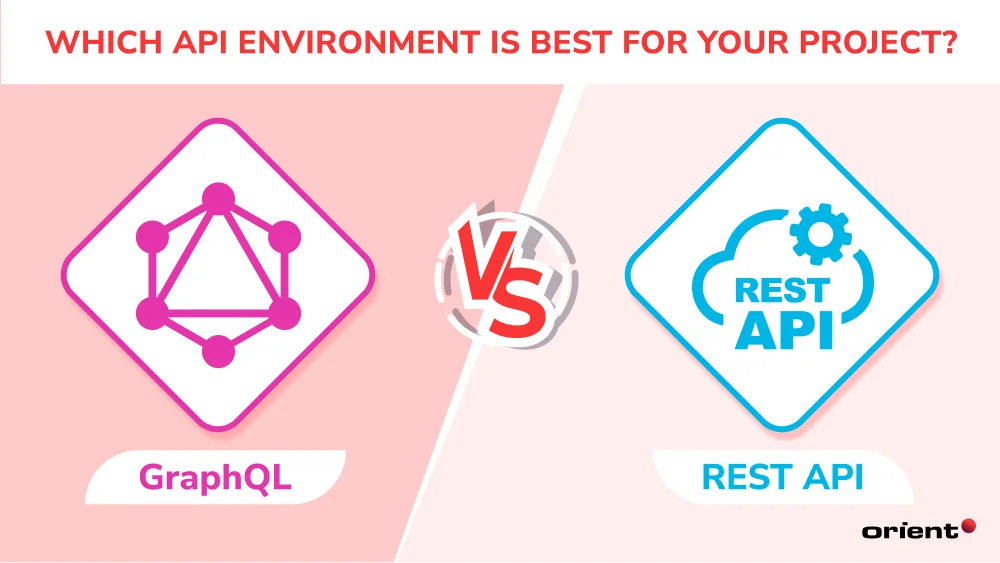GraphQL Vs. REST API: Which API Environment Is Best for Your Project?

Content Map
More chaptersGraphQL and REST API are two effective ways to develop backend APIs. REST API has been the industry standard for over two decades. However, GraphQL is gaining traction. It aims to overcome the issues present in REST APIs by reducing the number of data requests that users make, among other benefits. By understanding the difference between GraphQL and REST API, you can choose the best architectural style for your project.
Read on to find out what GraphQL and REST API are, their similarities and differences, and when to use each one.
Key Takeaways:
- GraphQL and REST API are two architectural styles used to build web APIs
- Both GraphQL and REST API are stateless. They both run on a client-server model. They both communicate using the HTTP protocol.
- GraphQL and REST API differ in how they retrieve data, manage error handling, and manage versioning.
What Is GraphQL?

GraphQL, internally developed by Facebook in 2012 and released open source to the public in 2015, is known as a query language and server-side runtime for APIs.
GraphQL overcame many issues that developers – specifically social media platform developers – would face with RESTful APIs. The most prominent issue was the amount of code required to process multiple API calls, which resulted in slow performance and a poor user experience for social media platforms.
To overcome the limitations of REST APIs, GraphQL can:
- Use a single endpoint to process GraphQL requests: Retrieve exactly the data users need in a single request, avoiding over-fetching and under-fetching.
- Eliminate the need for versioning: Create a new endpoint each time an API changes. Since GraphQL returns only the data that a user specifically requests, any new capabilities (added by new types and new fields) will not result in a breaking change.
- Support real-time updates through subscriptions: Allow a server to push updates to a client whenever an event occurs.
What Is REST API?

A REST API conforms to the constraint of the REST architectural style. It allows web services and systems to communicate with each other via the HTTP protocol. Any API that follows the six guiding constraints of REST is considered RESTful. Those six constraints are:
- Uniform Interface: Use HTTP verbs (GET, PUT, POST, DELETE) for an HTTP response.
- Client-server: Give each system a unique role. One server makes requests, while the other receives requests.
- Stateless: Make each request self-descriptive, with enough context for the server to comprehend each request.
- Cacheable: Allow clients to cache any representation.
- Layered system: Allow clients to deploy APIs on one server and perform other functions (store data, authenticate requests) on other servers.
- Code on Demand (Optional): Enable software to send executable code from a server to a client.
REST APIs use URIs (unique resource identifiers) to address resources. They also work by having multiple endpoints perform CRUD (create, read, update, and delete) functions using the following HTTP verbs:
- HTTP POST (Create): Sends an entity through a POST message to create a resource on a server.
- HTTP GET (Read): Requests a resource through a specific endpoint.
- HTTP PATCH (Update): Makes partial modifications to a resource through a resource-specific endpoint.
- HTTP DELETE (Delete): Deletes a resource through a resource-specific endpoint.
What Are the Similarities Between GraphQL and REST API?
Both GraphQL and REST API are popular architectural styles for developing backend APIs. They are similar because they are stateless (the GraphQL server does not save a response between requests) use a client-server model (a request from a single client leads to responses from a single server) and use HTTP to communicate over the web. Choosing the right environment is a vital component of API product management.
Furthermore, both GraphQL and REST API refer to any object or data as a resource. And each resource has a URI. A great example of a resource is a post on a social media platform. Each post has its own URI (/posts/456) and its own set of operations (GET, to retrieve the post via REST).
Lastly, both architectural styles support most of the same data formats, such as JSON (JavaScript object notation), a popular data exchange format as it is self-describing, lightweight, and easy to understand. Also, GraphQL API and REST API support less popular but still relevant data formats like XML and HTML. Best of all? They are also compatible with any database structure and programming language, be it client-side or server-side.
What Are the Differences Between GraphQL and REST API?

There are key differences between GraphQL and REST API. The most prominent are how they manage data retrievals, versioning, and error handling. These differences influence how developers use these tools and which projects they use them on. The environment you choose can also influence the API security best practices you must follow.
Are you planning on outsourcing your software development? If so, you want to partner with a team that can translate complex technical information into terms you can understand. That is why, when you work with Orient Software, we take the time to understand your situation and help you choose an API solution that meets your unique requirements.
Here is a more detailed breakdown of the differences between these tools.
Endpoints
GraphQL sends and receives requests through a single endpoint, which helps reduce the number of requests a client makes to retrieve data. Instead of submitting multiple requests to retrieve data from multiple data sources, GraphQL can retrieve only explicitly requested data in a single pass.
On the other hand, REST APIs contain multiple endpoints. Each endpoint receives requests about a specific resource on its server. For example, one endpoint might allow a client to modify a post on their social media page, while another endpoint might allow a client to respond to another user’s post. With a REST API, each endpoint has a dedicated URL.
Versioning
REST APIs use versioning to describe when a change occurs. For example, when developers change the data structure or operations. Developers typically label these changes in the URL, which may look like this: www.example.com/api/v2. Without versioning, the risk of service disruptions and system errors may increase – especially in the case of a third-party API.
On the other hand, GraphQL does not require versioning. Why? Because it can retrieve the exact data a user needs without fear of over-fetching or under-fetching. Hence, it does not matter if new fields or operations are present, as they do not affect clients that don’t need those fields.
Error Handling
REST APIs use HTTP status codes, which indicate the status or success of a request. The three most common status codes are 200 (a successful request), 400 (a client error), and 500 (a server error). Unfortunately, these error codes are only helpful for web users, as the REST architecture itself has no specification for errors. As a result, developers may need to read documentation to understand the context of a specific error message.
GraphQL takes a different approach to handling errors. Instead of using HTTP for status codes, the system will always return a 200 OK status code, even if the API request does not result in an error. However, there are two categories of error types, namely syntax errors and execution errors, which developers can use to determine the nature of a code error.
When to Use GraphQL and REST API
The great thing about REST and GraphQL is that you can use both interchangeably. However, there are certain situations where one is preferable to the other. Knowing which architecture is the right fit will assist with your API development project.
Use GraphQL if you have:
- Limited bandwidth: In this case, you probably want to reduce the number of data requests and responses. If so, a GraphQL schema is a good choice, as it only retrieves and sends the data that users ask for.
- To combine data points to one endpoint: If you need to retrieve data from multiple locations, such as a remote server in different geographic locations, then GraphQL will enable you to send and retrieve data from those sources effortlessly.
- Complicated client requests: This may apply if your API has a wide range of client requests, each one with specific responses.
Use REST API if you have:
- To build a smaller app: If you are building a small-scale app with minimal endpoints, you do not need GraphQL to return data from multiple passes in a single request. In this case, REST API will do the job.
- Simple data querying requirements: If your app does not require adaptable queries – queries that you can adjust based on the unique requirements of each user – then you do not need GraphQL. Therefore, stick with REST API.
- Clients that will use the API the same way: Will most of your user base have access to the same features and functions? If so, you can use REST API, as you only need a simple, uniform method to access and manipulate data.
Choosing the Best Backend Environment for APIs
As you can see, both GraphQL and REST API are effective ways to fetch data from the internet. But they each have their pros, cons, and use cases. But how do you know which backend environment is best for you?
If you plan to outsource your software development, then your development team will choose for you. However, that doesn’t mean you have to stay in the dark. Your dedicated team should justify its decision, explaining the benefits and practicalities of their chosen environment.
At Orient Software, we have years of experience integrating APIs into all kinds of web services. Our experienced frontend and backend teams of developers will help you unlock the full potential of your API integration. Whether you need to integrate first- or third-party APIs into your project, our talented developers can seamlessly incorporate them into your web app or web service.
Contact us today. Find out how our web application development services can contribute to your project’s success.







